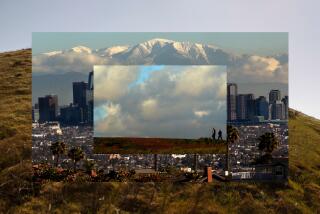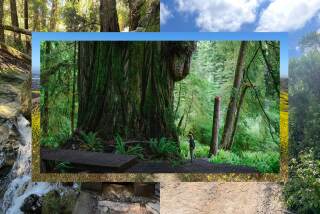Juans and All, Procession Retraces De Anza’s Trek
- Share via
CALABASAS — It would have been a scene out of 18th century California, with explorer Juan Bautista de Anza, his wide-brimmed black hat cocked just so, hoisting the red and gold crest of Carlos III, king of Spain.
An epic scene, except for the roller-bladers.
Or the joggers, the mountain bikers and the motorists in Chevy Suburbans.
Two hundred and twenty-one years after De Anza led a collection of colonists from Sonora, Mexico, to settle the Bay of San Francisco, hundreds of Californians are retracing his steps to call attention to his namesake National Historic Trail.
“Historically, it is correct to be on a horse or foot,” conceded Jeannie Gillen, Southern California chairwoman of the Heritage Trails Fund. “In this day and age, it’s correct to have trails be multiuse.”
De Anza, a shrewd and quick-thinking frontier soldier of what was then New Spain, would probably approve of them employing all the resources at their disposal: the Ventura Freeway, for example, sections of which overlay some of the original route; ice chests full of Pepsi; padded riding pants.
In fact, as the procession stopped at Juan Bautista de Anza Park in Calabasas on Monday, there were two Juans. The one clad in the more rugged field uniform of orange and black poncho had just led the group through the morning leg, across the west San Fernando Valley. The second, dressed in the formal uniform of regal blue, with a three-cornered hat, would take a new contingent of 100 the 8.8 miles into Ventura County.
The commemorative trek began Oct. 12 in Hermosillo, Sonora, the state De Anza departed in the fall of 1775 with 240 settlers and 1,000 head of livestock.
Only Gillen and Nancy DuPont, executive director of the Heritage Trails Fund, are completing the entire journey by horseback. But hundreds of others are joining as the group has made its way from Mexico, across southern Arizona, and into California, riding or running or skating along for a distance before passing on to the next group a mochila, or saddlebag, containing welcoming proclamations and other reproductions of historical documents.
(The trekkers also hand off four bottles of water. All are from Sonora’s San Miguel River, sealed and clearly marked “nonpotable, do not drink,” to be poured ceremoniously into San Francisco Bay at journey’s end. But at a party after one early stage of the trip, an apparently intoxicated neo-adventurer quaffed a bottle and a half.)
While some portions of the trail--which cuts through public and private property in two countries, two states and 20 counties--are marked, most are not.
One reason for the expedition is to remind people the trail currently exists mainly on a map and to encourage them to maintain it, mark it and, where it crosses private property, to make it accessible to the public--on horseback or otherwise.
After local politicians delivered speeches via a public address system and one Juan passed authority to the other, the group in Calabasas prepared to move out.
The mountain bikers checked their digital speedometers, one walker slipped into well-cushioned Rockport shoes, and, for a few moments, the sound of a jetliner passing overhead blended almost harmoniously with the cheerful tune of a mariachi band.
More to Read
Sign up for The Wild
We’ll help you find the best places to hike, bike and run, as well as the perfect silent spots for meditation and yoga.
You may occasionally receive promotional content from the Los Angeles Times.






